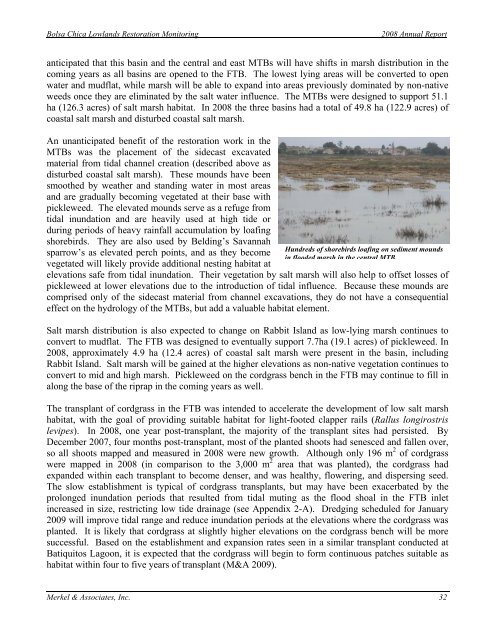2008 Annual Monitoring Report (pdf 10.9MB) - Bolsa Chica ...
2008 Annual Monitoring Report (pdf 10.9MB) - Bolsa Chica ...
2008 Annual Monitoring Report (pdf 10.9MB) - Bolsa Chica ...
Create successful ePaper yourself
Turn your PDF publications into a flip-book with our unique Google optimized e-Paper software.
<strong>Bolsa</strong> <strong>Chica</strong> Lowlands Restoration <strong>Monitoring</strong><br />
<strong>2008</strong> <strong>Annual</strong> <strong>Report</strong><br />
anticipated that this basin and the central and east MTBs will have shifts in marsh distribution in the<br />
coming years as all basins are opened to the FTB. The lowest lying areas will be converted to open<br />
water and mudflat, while marsh will be able to expand into areas previously dominated by non-native<br />
weeds once they are eliminated by the salt water influence. The MTBs were designed to support 51.1<br />
ha (126.3 acres) of salt marsh habitat. In <strong>2008</strong> the three basins had a total of 49.8 ha (122.9 acres) of<br />
coastal salt marsh and disturbed coastal salt marsh.<br />
An unanticipated benefit of the restoration work in the<br />
MTBs was the placement of the sidecast excavated<br />
material from tidal channel creation (described above as<br />
disturbed coastal salt marsh). These mounds have been<br />
smoothed by weather and standing water in most areas<br />
and are gradually becoming vegetated at their base with<br />
pickleweed. The elevated mounds serve as a refuge from<br />
tidal inundation and are heavily used at high tide or<br />
during periods of heavy rainfall accumulation by loafing<br />
shorebirds. They are also used by Belding’s Savannah<br />
sparrow’s as elevated perch points, and as they become<br />
vegetated will likely provide additional nesting habitat at<br />
Hundreds of shorebirds loafing on sediment mounds<br />
in flooded marsh in the central MTB.<br />
elevations safe from tidal inundation. Their vegetation by salt marsh will also help to offset losses of<br />
pickleweed at lower elevations due to the introduction of tidal influence. Because these mounds are<br />
comprised only of the sidecast material from channel excavations, they do not have a consequential<br />
effect on the hydrology of the MTBs, but add a valuable habitat element.<br />
Salt marsh distribution is also expected to change on Rabbit Island as low-lying marsh continues to<br />
convert to mudflat. The FTB was designed to eventually support 7.7ha (19.1 acres) of pickleweed. In<br />
<strong>2008</strong>, approximately 4.9 ha (12.4 acres) of coastal salt marsh were present in the basin, including<br />
Rabbit Island. Salt marsh will be gained at the higher elevations as non-native vegetation continues to<br />
convert to mid and high marsh. Pickleweed on the cordgrass bench in the FTB may continue to fill in<br />
along the base of the riprap in the coming years as well.<br />
The transplant of cordgrass in the FTB was intended to accelerate the development of low salt marsh<br />
habitat, with the goal of providing suitable habitat for light-footed clapper rails (Rallus longirostris<br />
levipes). In <strong>2008</strong>, one year post-transplant, the majority of the transplant sites had persisted. By<br />
December 2007, four months post-transplant, most of the planted shoots had senesced and fallen over,<br />
so all shoots mapped and measured in <strong>2008</strong> were new growth. Although only 196 m 2 of cordgrass<br />
were mapped in <strong>2008</strong> (in comparison to the 3,000 m 2 area that was planted), the cordgrass had<br />
expanded within each transplant to become denser, and was healthy, flowering, and dispersing seed.<br />
The slow establishment is typical of cordgrass transplants, but may have been exacerbated by the<br />
prolonged inundation periods that resulted from tidal muting as the flood shoal in the FTB inlet<br />
increased in size, restricting low tide drainage (see Appendix 2-A). Dredging scheduled for January<br />
2009 will improve tidal range and reduce inundation periods at the elevations where the cordgrass was<br />
planted. It is likely that cordgrass at slightly higher elevations on the cordgrass bench will be more<br />
successful. Based on the establishment and expansion rates seen in a similar transplant conducted at<br />
Batiquitos Lagoon, it is expected that the cordgrass will begin to form continuous patches suitable as<br />
habitat within four to five years of transplant (M&A 2009).<br />
Merkel & Associates, Inc. 32






